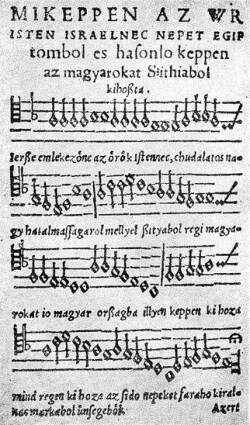Music history of Hungary
During this period a bishop from Venice wrote the first surviving remark about Hungarian folk song when he commented on the peculiar singing style of a maid.
[1] The earliest documented instrumentation in Hungarian music dates back to the whistle in 1222, followed by the koboz in 1326, the bugle in 1355, the fiddle in 1358, the bagpipe in 1402, the lute in 1427 and the trumpet in 1428.
Szavolcsi notes the author of the Sándor Codex (early 16th century), who described secular music as accompanied by "fiddle, lute, drums and cimbalom... and used tenor, discant and contratenor" singers, meaning it was in the style of the motet.
[3] The most significant musician of this period was Sebestyén Tinódi Lantos, the "greatest stylist and master of expression of ancient Hungarian epic poetry... whose heritage the people's music of two centuries was unconsciously nourished".
[3] Accentuated declamation was fashionable in music education during the early 16th century; a more rigid choir style is represented by a collection called the Melopoeiae, from 1507.
[3] The poet Bálint Balassi remains well regarded for his poems from this period, which were based on Polish, Turkish, Italian and German melodies, and may have also been influenced by the villanella.
Religious and secular music were closely connected at this time, and documentation of the former grew with the publication of many songbooks filled with free psalm paraphrases called lauds, facilitating the practice of communal singing among the nascent Protestant churches.
[4] Some of these musicians were German, Polish, French or Italian, and even included a Spanish guitarist at the court of Gábor Bethlen, Prince of Transylvania.
[4] János Kájoni Organo Missale of 1667 was the first experiment in the creation of a new kind of Hungarian church music, a style that strung together short motives that were shortened, extended or syncopated in a complex rhythmic structure.
[4] Their influences include elements of Polish, Romanian, Slovak and Ukrainian music in addition to Hungarian melodies.
During the 18th century, students at Hungary's Calvinist colleges, some of whom, being minor nobles, lived in small rural villages, brought with them to their schools their regional styles of music.
Like much of Hungarian music at the time, it was focused on the melody, with a subordinate text; in spite of this, the vocals became a major part of verbunkos.
[5] By the middle of the 19th century, verbunkos was a major symbol of Hungarian culture, and numerous people published groundbreaking studies and collections of the field.
[6] András Bartay's 1835 study of Hungarian harmonics, Magyar Apollo and his 1833-34 Eredeti Népdalok, were pioneering works in the field.
[6] In 1838, a young Franz Liszt was inspired to travel home to Hungary, studying the music of the country; he would go on to incorporate what he learned in many of his world-famous compositions.
[6] Other composers from this period included Béni Egressy, who used 18th century folk songs in his compositions, Kálmán Simonffy, who was the "most original and most inventive" songwriter of the era, whose works "most nearly approached the ideal of 'popular melodic culture', as well as lesser-known figures like Gusztáv Szénfy, Gusztáv Nyizsnyai and Ignác Bognár.
[6] The Hungarian operetta first appeared in the 1860s, popularized by Ignác Bognár, Geza Allaga and Jeno Huber, followed by Elek Erkel and György Bánffy; in the early 20th century, the Viennese style predominated in the work of Huszka, Pongrác Kacsóh, Buttykay, Jacobi, Kálmán and Lehár.
